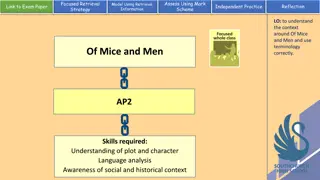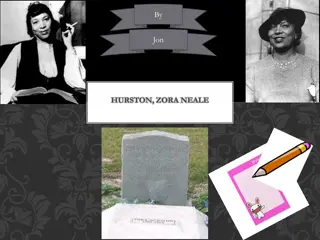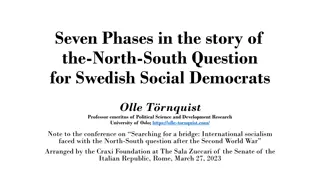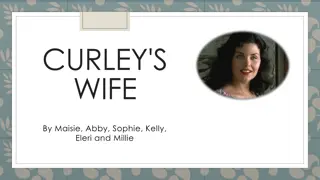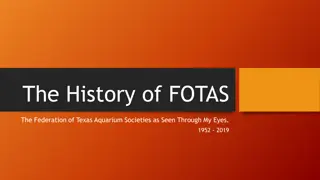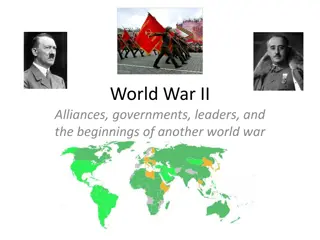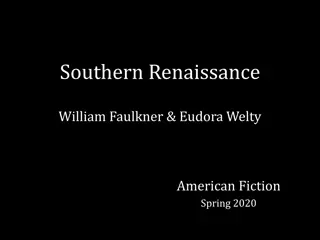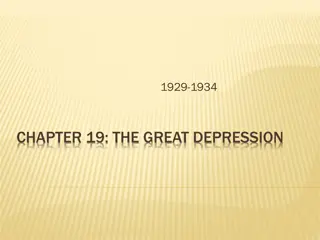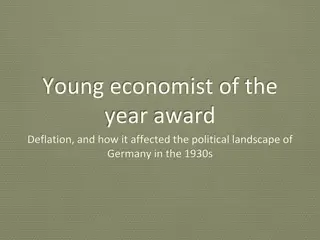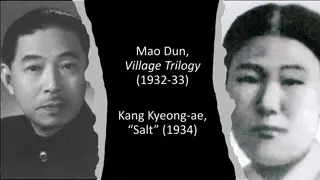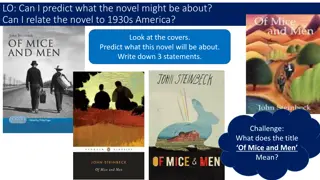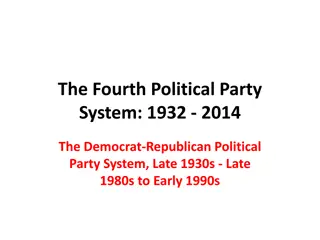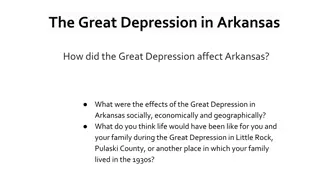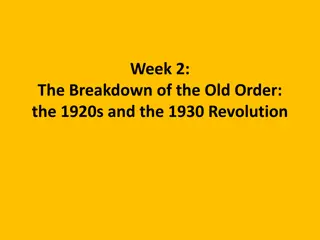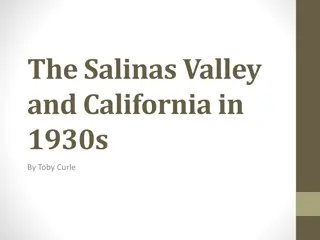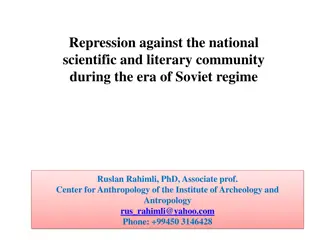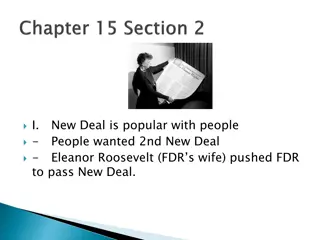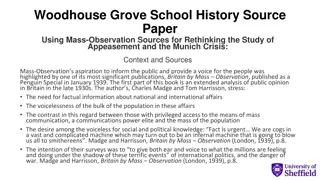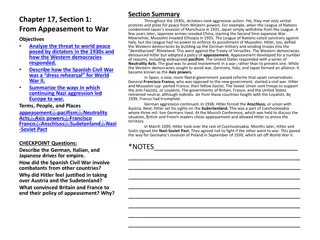Understanding Society in America in the 1930s Through "Of Mice and Men" Context
Explore the societal issues faced in America during the 1930s through an analysis of how John Steinbeck reflects these themes in his novella "Of Mice and Men." Delve into topics such as the Great Depression, migrant workers, the American Dream, racism, and sexism, and understand the characters' role
1 views • 29 slides
The Dust Bowl: Impact of the 1930s Drought
The Dust Bowl of the 1930s was a devastating period marked by severe drought, high winds, and dust storms in the Great Plains. It affected states like Texas, Oklahoma, Kansas, and more, leading to ruined crops, livestock losses, dust pneumonia deaths, and economic hardships. The lack of soil conserv
3 views • 14 slides
Zora Neale Hurston: African-American Writer of the Harlem Renaissance
Zora Neale Hurston, born in Notasulga, Alabama, in 1891, was a prominent African-American writer known for her works reflecting the African-American culture and folklore. Growing up in Eatonville, Florida, and later studying at Barnard College, she stood out among her contemporaries for her portraya
2 views • 4 slides
History and Achievements of Lesetja Primary School
Lesetja Primary School, founded by the Methodist Church in the 1920s-1930s in South Africa, transitioned from church to government management during the Bantu Education era. The school has a rich history of notable principals, steady growth, and outstanding student achievements across various fields
0 views • 34 slides
Evolution of Mathematical Theories and Proof Systems
Development of mathematical theories such as model theory, proof theory, set theory, recursion theory, and computational complexity is discussed, starting from historical perspectives with Dedekind and Peano to Godel's theorems, recursion theory's golden age in the 1930s, and advancements in proof t
1 views • 29 slides
Phases of the North-South Question and Social Democracy Evolution
Explore the evolution of Social Democracy in relation to the North-South question through seven phases outlined by Olle Törnquist. The discussion spans from the 1930s to modern times, highlighting shifts in international cooperation, economic ideologies, and political conditions that have influence
0 views • 10 slides
Analysis of Curley's Wife in 'Of Mice and Men'
Curley's wife, a character in John Steinbeck's novel "Of Mice and Men," is depicted as a possession of her husband, striving to break free from the confines of her unhappy marriage. She harbors dreams of independence and success but is limited by the societal norms and sexism prevalent in 1930s Amer
0 views • 8 slides
The Evolution of Aquarium Societies in Texas: A Historical Journey from 1932 to 2019
Explore the history of FOTAS - the Federation of Texas Aquarium Societies, from its inception in 1952 to its evolution into a yearly convention. Discover the chronology of aquatic organizations in Texas from the 1930s, including the formation of various aquarium clubs and their contributions to the
0 views • 33 slides
Exploring the Themes of Cultural Identity in Tally's Blood
The play "Tally's Blood" by Ann Marie di Mambro delves into the multifaceted themes of cultural identity, racism, integration, and generational relationships within Scottish and Italian communities. Set against the backdrop of Glasgow, the narrative unfolds over two decades, highlighting the challen
0 views • 24 slides
Japan's Aggression in China: The Atrocities of Invasion
Japan's aggressive expansion in the 1930s led to the invasion of China, marked by incidents like the seizure of Manchuria and the brutal atrocities in Nanjing. The international community's failure to intervene effectively underscores the importance of collective action in global affairs, a lesson s
0 views • 24 slides
America's Involvement in World War II: A Comprehensive Overview
Americans in the 1930s grappled with the rise of fascism and totalitarianism in Europe while striving to maintain isolationism. Events such as the Panay Incident and the Lend-Lease Act eventually drew the U.S. into WWII, shaping views on freedom, mobilization, and the homefront, including changes in
1 views • 12 slides
Exploring the Historical Significance of the Eucharistic Congress, 1932
This resource aims to help students assess the historical significance of the Eucharistic Congress held in 1932. It focuses on fostering critical thinking skills and uses an enquiry-focused approach to clarify learning objectives. The content includes discussion on the context of Ireland and the Cat
0 views • 42 slides
Unraveling the Charm of Screwball Comedy Films
Dive into the world of screwball comedy films, a genre that emerged in the mid-1930s, characterized by zany events, witty dialogue, and battles of the sexes. These films disrupt the ordered lives of heroes with the arrival of heroines, leading to humorous misadventures and satirical takes on social
0 views • 7 slides
Exploring the World of Film Noir: Shadows, Mystery, and Intrigue
Delve into the captivating realm of film noir with a journey through its origins, unique characteristics, and iconic movies. Uncover the influence of low budgets, gritty source materials, atmospheric lighting, and innovative camera work that defined this cinematic genre. Discover how European direct
14 views • 24 slides
Understanding the Impact of World War I on Global History
Delve into the multiple causes and effects of World War I, such as militarism, imperialism, nationalism, and alliances. Explore how the global scope of WWI shaped the 1920s and 1930s, leading up to World War II. Gain insights into key events and dynamics of this transformative period.
0 views • 97 slides
Affinity Chromatography: A Breakthrough in Biochemical Research
Affinity chromatography, developed in the 1930s by A. Wilhelm Tiselius, is a vital technique for studying enzymes and proteins. It relies on the specific affinity between biochemical compounds and utilizes matrices like agarose for binding sites. Ligands such as amino and hydroxyl groups play crucia
1 views • 27 slides
The Rise of Dictators and the Beginnings of World War II
The content delves into the events leading up to World War II, highlighting key historical moments such as the rise of dictators like Hitler, Mussolini, and Stalin, along with significant milestones such as the invasion of Poland and the bombing of Pearl Harbor. It emphasizes the ideologies of fasci
0 views • 48 slides
Crystal Field Theory and Color Exhibited by Coordination Compounds
Crystal Field Theory (CFT) explains the colors exhibited by coordination compounds based on the absorption of light and electron transitions in d-orbitals. The theory describes how ligands interact with transition metal ions, causing the d-orbitals to split in energy levels. This split results in th
0 views • 30 slides
Social and Historical Background of Early 20th Century England
The early 20th century in England was marked by significant events such as the reigns of Edward VII and George V, the Boer War, World War I, and the rise of the political left during the economic depression of the 1930s. The period also saw the abdication of Edward VIII and the reign of George VI du
0 views • 7 slides
Southern Renaissance: A Reflection on American Southern Literature
The Southern Renaissance in American literature, exemplified by authors like William Faulkner and Eudora Welty, emerged in the 1920s and 1930s as a response to the perceived neglect of the South. This period saw a resurgence of Southern uniqueness, culture, and identity, tackling themes of history,
0 views • 16 slides
The Great Depression: Stock Market Crash and Economic Turmoil of 1929-1934
In the early 1930s, the United States faced a severe economic downturn known as the Great Depression. Triggered by the stock market crash of 1929, the nation experienced widespread financial devastation, with millions of people losing their jobs, homes, and savings. The period was marked by economic
0 views • 32 slides
Economic Crisis and Political Turmoil in 1930s Germany
Deflation and the Great Depression had a profound impact on Germany in the 1930s, leading to widespread unemployment, economic turmoil, and political unrest. The Weimar Republic faced severe challenges as the Nazi party gained power amidst the economic crisis, exacerbated by the aftermath of World W
0 views • 16 slides
Stories of Village Life and Silk Production in the 1930s
The works "Village Trilogy" by Mao Dun and "Salt" by Kang Kyeong-ae provide a glimpse into the rural life of the 1930s. The excerpt describes the tender care given to silkworms in the production of silk, highlighting the intricate details and struggles faced in this industry during that era.
0 views • 18 slides
Understanding Steinbeck's Message in "Of Mice and Men
Explore the deep thematic connections between Robert Burns' poem "To a Mouse" and John Steinbeck's novella "Of Mice and Men," delving into the struggles of the characters in the context of the 1930s American society. Uncover the underlying message that Steinbeck conveys through his portrayal of the
0 views • 4 slides
Exploring the Character of George in 1930s America for IGCSE Prose
Steinbeck's portrayal of George in the context of 1930s America reflects themes of the post-depression and dustbowl era, societal collapse, the American Dream, discrimination, and the challenges faced by itinerant workers. George's character serves as a lens through which to examine the failures of
0 views • 11 slides
Understanding Prejudice in "To Kill a Mockingbird
In "To Kill a Mockingbird," Scout and Jem's curiosity about their reclusive neighbor, Boo Radley, leads them to uncover deep-seated prejudices within their community. Boo's mistreatment by his family reflects societal ignorance towards mental health and disability in the 1930s. The theme of prejudic
0 views • 7 slides
Political Divisions and Purges in the Democrat-Republican Party System (1932-1938)
Divisions surfaced within the Democrat-Republican Party System in the late 1930s, marked by disputes over policies like Roosevelt's Court Packing Scheme and the Fair Labor Standards Act, leading to friction between Northern and Southern Democrats. President Roosevelt's attempt to purge conservative
0 views • 16 slides
Impact of the Great Depression on Arkansas: Social, Economic, and Geographical Effects Through Photographs
Explore the profound impact of the Great Depression on Arkansas through a series of thought-provoking photographs taken during the 1930s. Discover how the Great Depression affected the state socially, economically, and geographically, as depicted in images showcasing the struggles and resilience of
0 views • 15 slides
The Great Depression: Causes, Impact, and Government Response
The 1930s marked a period of economic turmoil known as the Great Depression. Misleading prosperity, overspeculation in the stock market, and flawed government policies all contributed to the devastating crash of 1929. As the economy collapsed, unemployment soared, businesses failed, and a sense of d
0 views • 20 slides
Character Summaries from "Men Should Weep
Explore the central protagonists, Maggie and John, in "Men Should Weep." Maggie, a strong and stoic working-class housewife, faces numerous challenges but ultimately takes control of her family. John, although loving, struggles with traditional male roles and faces humiliations as Maggie asserts her
0 views • 10 slides
Evolution of Fashion: Decades Unfolded
Explore the ever-changing world of fashion through the decades, from the Edwardian era's corsets and silhouettes to the free-spirited Roaring 20s, the elegant 1930s bias-cut dresses, and the practical yet stylish 1940s wartime fashion. Witness the evolution of trends and styles that shaped fashion h
0 views • 18 slides
Overview of Immunohistochemistry (IHC) in Diagnostic and Research Laboratories
Immunohistochemistry (IHC) is a technique used to detect antigens in tissue sections by utilizing antibodies that bind specifically to target antigens. This method has evolved since the 1930s and plays a vital role in disease diagnosis, drug development, and biological research. IHC combines anatomi
0 views • 19 slides
Air Pollution Episodes Through History: Causes, Effects, and Regulations
Explore the history of air pollution from the 1930s to 1960s, including key episodes in London, Meuse Valley, and other cities. Learn about the effects of air pollutants, regulatory actions taken, and the evolution of environmental awareness. Discover how industrial activities and population growth
0 views • 40 slides
Transformations in Brazil during the 1920s and 1930s
Brazil experienced significant changes in the 1920s and 1930s, including the rise of the military, economic growth post-World War I, demographic shifts with urban expansion, improved literacy rates, and the emergence of a growing middle class. These transformations highlighted the need for political
0 views • 20 slides
Men Should Weep: Explore the Glasgow Family Struggles in the 1930s
Ena Lamont Stewart's play "Men Should Weep" delves into the challenges faced by a Glasgow family during the Great Depression of the 1930s. Set against the backdrop of poverty, unemployment, and social upheaval, the play portrays the harsh realities of life below the breadline. Through the characters
0 views • 27 slides
Salinas Valley and California in the 1930s Historical Overview
Discover the historical significance of the Salinas Valley in the 1930s, a major agricultural region in California where Dust Bowl migrants, Filipino labourers, and others worked amidst wage disputes and strikes. Explore the challenges and developments in Monterey County during that era, including p
0 views • 5 slides
Repression Against Azerbaijani Intellectuals During Soviet Regime
The era of Soviet regime in Azerbaijan was marked by severe repression against the national scientific and literary community. From early Bolshevik governance in 1920 to the 1930s, countless individuals, including prominent intellectuals, government members, and ordinary citizens, faced unjust trial
0 views • 30 slides
Impact of the New Deal Policies in the 1930s
The New Deal policies initiated by President Franklin D. Roosevelt during the 1930s aimed to address the challenges of the Great Depression. The programs provided relief to the unemployed, created jobs through public works projects, and established social security measures. Eleanor Roosevelt played
0 views • 7 slides
Mass Observation in Britain: A Tool for Public Understanding in the Late 1930s
In the late 1930s, Mass Observation played a vital role in understanding public opinion in Britain amidst international crises like the Munich Crisis. Through recruiting volunteers to provide personal observations and conducting focused surveys, Mass Observation aimed to give voice to ordinary peopl
0 views • 8 slides
Dictator Aggression and the Outbreak of World War II in the 1930s
Throughout the 1930s, dictators such as Hitler, Mussolini, and Japanese leaders took aggressive actions that threatened world peace. Western democracies responded with verbal protests and a policy of appeasement, allowing dictators to expand their empires unchecked. The Spanish Civil War served as a
0 views • 4 slides
